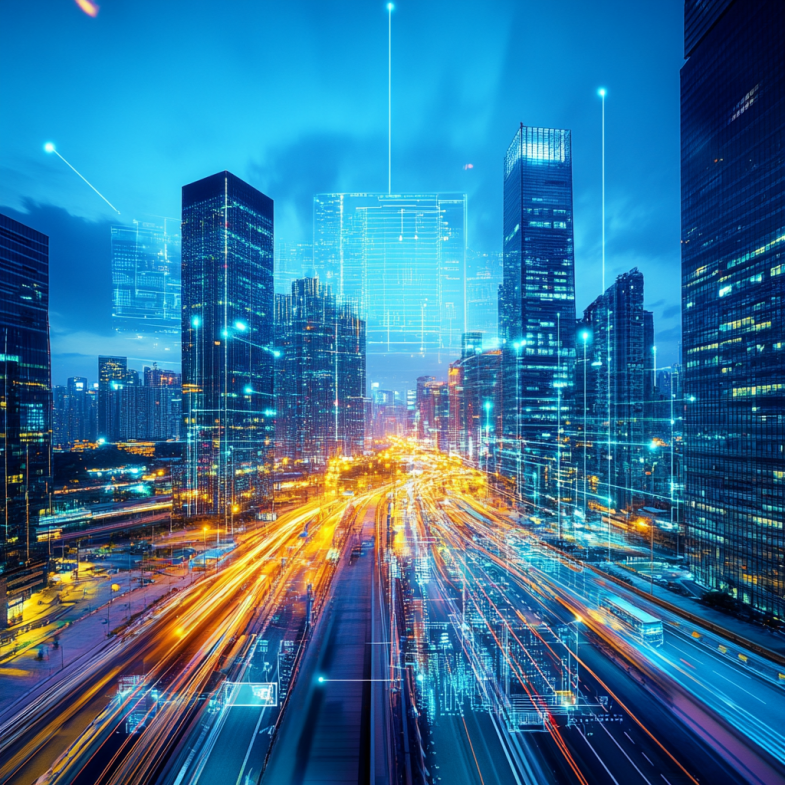Every year, more and more cities are starting to implement “smart” technologies to improve the quality of life of their residents. These technologies are aimed at optimizing the use of resources, improving transport systems, ensuring safety and reducing the impact on the environment. In this article, we will look at examples of “smart” technologies being implemented in cities and their impact on the environment and economy.
Chapter 1: What are Smart Cities?
Definition of a Smart City
A smart city is a city that uses advanced technologies to manage its resources and services in order to improve the quality of life of its residents. These technologies can include the Internet of Things (IoT), artificial intelligence (AI), big data and other digital strategy. The goal of a smart city is to make it more efficient, sustainable and comfortable to live in.
Benefits of Smart Cities
One of the main benefits of smart cities is increased resource efficiency. For example, energy management systems can automatically adjust lighting and heating depending on the time of day and weather conditions. This allows for significant reductions in energy costs and a smaller impact on the environment.
Another important benefit is the improvement of the transport system. Smart technologies allow for the optimization of public transport routes, reduced congestion, and reduced air pollution. In addition, such systems provide greater safety for drivers and pedestrians.
Chapter 2: Examples of Smart Technologies in Cities Smart Lighting
One of the most common smart technologies is a smart lighting system. These systems use motion and light sensors to automatically turn street lights on and off. This allows for energy savings of up to 80% compared to traditional lighting systems. In addition, smart lights can be equipped with CCTV cameras and air pollution sensors, making them multifunctional devices.
Smart Energy
Smart Grids also play an important role in creating smart cities. These systems allow for real-time monitoring of electricity consumption and automatic regulation of power supply based on demand. This helps reduce the load on the power grid and prevent power outages. In addition, smart grids can integrate renewable energy sources such as solar panels and wind turbines, which contributes to the sustainable development of cities.
Smart transport
Smart technologies are actively being implemented in city transport systems. For example, traffic management systems can analyze data from sensors and cameras to optimize traffic lights and reduce congestion. Smart parking systems help drivers find free spaces, which reduces search time and air pollution. In addition, many cities are introducing car sharing and bike rental systems that allow residents to move around the city without having to own a car.
Smart buildings
Smart technologies are also used in building construction. Smart homes and offices can automatically adjust temperature, lighting, and ventilation depending on the time of day and the presence of people. This not only increases comfort, but also reduces energy costs. In addition, smart buildings can be equipped with security systems that include CCTV cameras, motion sensors, and access control systems.
Chapter 3: The Environmental Impact of Smart Technologies Reducing Carbon Emissions
One of the main benefits of smart technologies is their ability to reduce carbon emissions. Smart energy and traffic management systems help reduce the consumption of fossil fuels, which has a positive impact on the environment. For example, smart lighting systems can reduce electricity consumption by 50-80%, and smart transportation systems can reduce the number of cars on the road, which in turn reduces air pollution.
Making Cities More Sustainable
Smart technologies also help make cities more sustainable. For example, smart grids can integrate renewable energy sources such as solar panels and wind turbines, making cities less dependent on fossil fuels. In addition, smart water management systems can help reduce water loss and improve water efficiency.
Chapter 4: The Impact of Smart Technologies on the Economy
Creating New Jobs
The introduction of smart technologies opens up new opportunities for job creation. For example, the development and maintenance of smart lighting, energy, and transportation systems require highly skilled professionals. In addition, smart cities can become hubs for innovation, where new start-ups and companies can develop, creating providing products and services based on smart technologies.
Reducing operating costs
Smart technologies can significantly reduce the operating costs of urban systems. For example, automation of energy consumption and traffic flow management can reduce energy and fuel costs. In addition, smart systems can prevent accidents and equipment breakdowns, which also helps reduce the costs of their repair and replacement.
Smart technologies have great potential to improve the quality of life in cities. They allow you to optimize the use of resources, improve transport systems and ensure greater safety for residents. In addition, these technologies have a positive impact on the environment and the economy, contributing to the sustainable development of cities. However, for the full implementation of smart technologies, it is necessary to solve a number of technical and social problems, such as data protection and ensuring equal access to new technologies.


